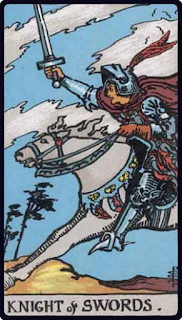
Representing discipline; the Knight of Swords is associated with the application of theory through practice, the Knight of Swords represents independent thought. The Knight acts based on their intuition and their own instincts. Their actions are guided by discipline and their own authority empowered by the will of the cause they serve.
In the upright state the Knight of Swords is a sign that what you have learned must be practised; you will find yourself retreading familiar ground with the warning not to repeat past mistakes. There is a warning here that new conflicts could arise if mistakes are made, remember to maintain discipline in your approach.
In the inverted state the Knight of Swords represents the reckless nature and desire to discount past experience as an anomaly and to repeat past mistakes believing they will lead to a different outcome.
In the Rider-Waite deck the Knight of Swords depicts a Knight upon his steed with a sword in hand outstretched riding forward into battle. The Knight rides into the wind emphasising the resistant forces pushing back against their actions. The horse is enrobed with a collar of golden butterflies representing transformation and evolution set against a pale blue representing tranquillity.
Here the role of the Knight of Swords emphasises that our motivations determine our nature, not the actions in themselves. Moral relativism guides the Knight, they ride forward in full knowledge of their actions, with experience of past conflicts, the actions they take are informed, and the consequences belong entirely to the Knight. Where the initiate in the 2 of Swords acted on blind faith, the Knight acts with conviction. The initiate entered the fray not knowing the magnitude of the conflict that they would engage with, whereas the Knight understands what they are confronting, they do not fight every fight but instead choose their battles wisely.
In self-reflection the Knight of Swords serves as a prompt to consider the sources of wisdom and knowledge at your disposal and the example they set for you to follow. Where the Page of Swords represents learning through observation, the Knight of Swords represents learning through deference to authority. This is your opportunity to take your attempts to rationalise the behaviours of others and identify the limit of your understanding and in turn identify a source of knowledge beyond yourself that you can draw upon for answers.
Where the Page of Swords has failed to deliver understanding and the existing external sources you have relied upon have failed to contribute, the simplest question to ask is “Who would understand this?” and consider who or what you can consult for guidance outside of your sphere of influence.
The distinction between the Knight of Swords and the Page of Swords is the effect of recognising the limit of our understanding and that of those who are part of our life at present. The Knight of Swords in this regard can represent a spiritual journey, or a journey of self-discovery, or pilgrimage to a source of wisdom that you regard with reverence; in manners relating to love this could be a parent or guardian, in education it may be a specific teacher, in religion it may be a Priest, Rabbi, or Imam, an authority whose wisdom you recognise but do not engage with as regularly as you do those of your social circle.

No comments:
Post a Comment
All comments are moderated before they are published. If you want your comment to remain private please state that clearly.